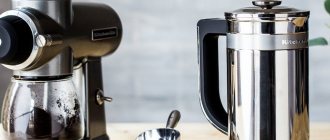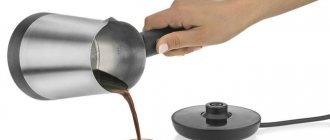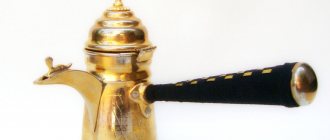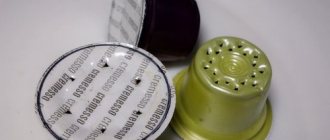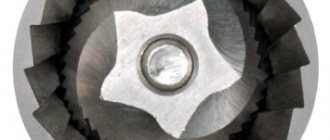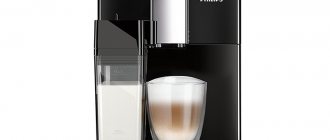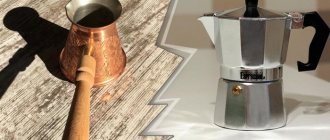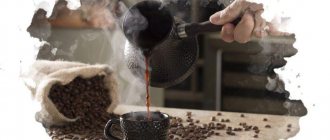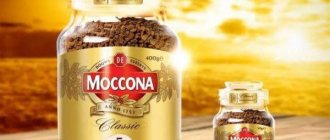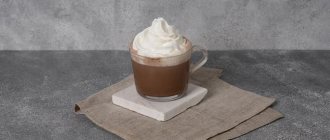A Turkish coffee pot called ibrik or cezve is an ideal device for preparing specialty coffee. Traditionally they are made of copper, but today Turks made of stainless steel, glass, and ceramics are also common.
Among the many devices designed for brewing coffee, a ceramic pot is the most popular after copper ones.
Advantages and disadvantages of ceramic Turks.
The first Turks sculpted from clay, which was subsequently fired. An inexpensive category of cezves is metal and made of copper. The ceramic Turk came to replace it relatively recently. The popularity of ceramic models is deserved by their ease of maintenance and the possibility of repeated use for different types of coffee beans.
The basis for earthenware and ceramic dishes is clay. Subsequently, it is fired in a kiln. A clay Turk is not covered with enamel - this is its main difference from ceramics.
View this post on Instagram
Posted by Moonflower Tea Boutique (@moonflower113) Oct 8, 2021 at 12:35 pm PDT
The glassy glaze that coats the ceramic pot increases strength. The coating makes it easy to clean. Coffee brewed in a ceramic pot has a unique aroma and taste. The coating protects the clay from oxidation.
Ceramic cezve does not take away the aroma of the drink, therefore it is used for various varieties, unlike metal predecessors.
The disadvantage of ceramic cezves is fragility, slow heating and cooling. Preparing the drink requires close attention. Turning off the gas does not guarantee that the coffee will not boil over. The disadvantage of enameled clay is its high sensitivity to temperature fluctuations. Rinsing with cold water immediately after heating is not acceptable, as is careless handling.
The purchase price is not in favor of ceramic products. Metal analogues cost one and a half to two times less.
Pros and cons of clay Turks
Turks made from clay have a number of advantages. Among them are:
- porosity of the structure, thanks to this the coffee is saturated with oxygen and reveals its taste to the maximum;
- environmental friendliness of the material. It is safe for human health;
- low thermal conductivity, due to which the vessel heats up evenly and cools slowly, which improves the quality of the finished drink.
In addition to their advantages, such Turks also have disadvantages. Among them are the fragility of containers and sensitivity to temperature changes.
During cooking, the clay retains the coffee aroma, which is why it is recommended to brew only one coffee variety in one vessel.
How to choose the right ceramic Turk
Before you start purchasing, decide on your wishes and requirements for the cezve. The quality of ceramic tableware is determined by a number of characteristics:
- Inspect the product upon purchase. Buy dishes in coffee shops, tea shops and online stores. The weak point of the product is the handle. The area connecting to the bowl is often the first to break. Some manufacturers, such as the Cerflame brand, offer models with a removable handle. If it breaks, you won't need to replace the casing. Scratches, chips, uneven coating are indicators of a low-quality product or improper storage.
- Volume. Ceramic cezve, designed for 1-3 cups of coffee, is popular. Keep in mind that heating the cezve takes a long time. The larger the volume, the longer this time.
- Form. The wide bottom of the ceramic Turk promotes uniform heating of the liquid. The classic shape is conical. The thicket settles faster to the bottom of the cone-shaped cezve.
How to properly care for a ceramic Turk
In order for a ceramic cezve to last a long time and have a good appearance, you need to follow several rules:
- first place the Turk on the stove and then turn on the heat (for uniform heating);
- make sure that the stove burner matches the diameter of the bottom of the Turk;
- do not use aggressive detergents;
- try not to scratch the surface with a sponge when washing or other utensils during storage;
- store the Turk in a stable position, because ceramics easily break when dropped.
Turk ceramic ceraflame
A good Turk is one of the components of aromatic coffee. The quality of the raw materials, functionality and appearance of the cookware are important. The Brazilian-made Ceraflame cezve will satisfy the wishes of anyone. The Certa Ceramica company offers several models with different colors, functional features and product prices.
View this post on Instagram
Posted by Turki for Coffee (@ceraflame.ukraine) Mar 3, 2021 at 1:00 PST
The brand offers four colors of cezves: black, dark chocolate, light brown and red. Step-by-step firing of clay Turks helps to achieve temperature resistance. Environmentally friendly materials make the product non-toxic to humans.
The average cost is 2500-3000 thousand rubles. Ceraflame Turks are made of high-quality materials, have thick walls and a sophisticated design.
Ceraflame ibriks with a hint of dark chocolate will fit perfectly into the interior of the Turk. The removable handle will make the ceramic easier to use and care for. The glaze of the product is less sensitive to temperature changes. It does not absorb odors and dirt.
View this post on Instagram
Posted by Ceraflame (@ceraflame) Feb 15, 2021 at 5:13 am PST
The price of an Ibriks cezve is approximately 2500 rubles. The buyer will need time to get used to cooking in it. Long heating and long cooling are a feature of this model. Don’t wait for foam to appear; bubbles are an indicator that the drink is ready.
Features of extraction processes when preparing Turkish coffee
The uniqueness of a coffee drink, properly prepared in a Turk, largely determines its aftertaste, which lasts a very long time. It is unlikely that it will be possible to achieve the same result with other methods of preparing coffee, since its formation is determined by the specific processes of boiling water in the cezve.
Boiling in a Turk is a process of several stages
At the first stage, gases (carbon dioxide, oxygen) dissolved in water begin to expand and form centers for the nucleation of microbubbles on coffee particles and microcracks in the walls of the cezve.
The second stage is an increase in the number of bubbles. The coffee particles on which they formed begin to float to form a cap. Microbubbles formed on the walls and bottom begin to break off and rise to the surface. If the thermal conductivity of the cezve material is sufficient or it provides the possibility of heating by infrared rays, then in the narrow part of the neck of the cezve the temperature is sufficient for enhanced extraction of oils from coffee particles.
At the third stage of heating, the process of increasing the diameter of the bubbles occurs. They reach such sizes that the Arichimedes force exceeds the force of adhesion to the surface of the cezve material, the bubbles begin to break off en masse and rush upward. If pure water were heated, the bubble on the surface would burst and steam would escape from the liquid. But when cooking in a cezve, a film of oils has already formed on the surface in the narrow part of the neck, which prevents the escape of air, so the formation of foam begins.
At the fourth stage , which begins when the temperature of the bottom layer of water increases to 50˚С and lasts until it rises to 80˚С, convection processes begin - warmer water rises up, colder water from the upper falls down. The contents of the cezve begin to mix intensively. At the same time, the number of bubble formation centers and places where they break off sharply increases, and heat transfer from the walls of the cezve increases. Intensive separation of bubbles enhances extraction processes.
At the fifth stage , which begins when the heating temperature reaches 70˚C, the massive formation of microbubbles (the so-called whitening of water) begins, and the intensity of their detachment from the surface of coffee particles sharply increases. Each bubble takes with it a certain amount of substances that determine the taste and aroma of coffee, the newly formed one repeats the process, the extraction intensifies.
At the sixth stage, bubbles rising from the bottom of the cezve begin to form threads that stretch to the surface, taking with them molecules of the liquid, and the formation of its turbulent movement begins.
The seventh stage is the stage of turbulent boiling; in the “water + coffee” system, intensive mixing of the drink begins, increasing the transition of substances into solution. This is the last stage of coffee preparation.
The eighth stage is the predominance of turbulent flow over convection flow, or active boiling, which is accompanied by the appearance of very large bubbles on the surface, seething. When preparing coffee, this stage is unacceptable.
To obtain real Turkish coffee with fully expressed taste and aroma, which are inherent in this type of bean, it is important to extend the time of stage seven as long as possible. When cooking on an electric stove, it is enough to set the heating mode to 95˚C when re-brewing the drink and warm it up for quite a long time at this temperature without allowing it to boil. Bedouin coffee is prepared in this way for up to eighteen hours.
The shape and material allow you to preserve coffee oils in the drink. Ceramic Turks have a high heat capacity, which allows you to slow down the process of making coffee and also simmer the coffee after the Turk is removed from the heat.
How to use
Pottery is picky about temperature and care. Enamel facilitates the process of operation, but does not protect against damage due to temperature fluctuations.
Do not drop ceramic cookware. The resulting chips and cracks will reduce the taste of the coffee.
Ceramic products are resistant to heat due to hardening during production. You can prepare Turkish coffee in the usual way: on a gas, electric stove or in a microwave oven.
On a gas stove
Preparing a drink on a gas stove will not affect the material of the ceramic pot. Pay attention to the stability of the cookware on the burner. If the size is not suitable, use a metal divider. Adjust the flame. Heating slowly over low heat will reveal the flavor of the beans and prevent them from boiling over.
View this post on Instagram
Posted by Pablo Istomyan (@100mean) Mar 22, 2021 at 11:22 am PDT
On an electric stove
Brewing coffee on an electric stove with arc-shaped burners requires dividers. The flat surface does not require additional devices.
On an induction hob
To use the ceramic Ceraflame Turk on an induction hob, a special metal plate is required - an adapter adapter. Without this device, it will not be possible to use it, due to the peculiarities of the induction cooker.
On a glass ceramic hob
The glass-ceramic plate allows you to use the cezve without discs or dividers.
Material
For cookware, such characteristics as thermal conductivity, strength, safety, cost and appearance are important. Over the course of several centuries, humanity has learned to produce cezves from copper and brass, aluminum and glass, clay and steel. The same coffee bean will give different flavors in different products. To choose the right pot for brewing coffee on a gas stove, first of all you need to pay attention to the material from which it is made.
Copper
The first Turks were made of copper. This metal remains the most popular material due to its optimal combination of characteristics.
- Thermal conductivity. High thermal conductivity promotes uniform heating of water.
- Price. Copper products are not the cheapest, but are quite affordable. Durability. This cezve will serve for years. It is better to wash it from the inside without using abrasive detergents so as not to damage the internal coating.
- Rich assortment. In any kitchenware store you can choose copper Turks of different sizes and designs.
A copper coffee pot is the best option, proven over centuries.
Brass
An alloy of copper and zinc is used in the production of coffee utensils along with pure copper. When deciding which is better, a brass pot or a copper one, you need to take into account the cost and physical properties of the two materials. Brass is harder and denser, and is more easily forged. Therefore, alloy products are easily given a classic conical shape and decorated with three-dimensional designs.
- Don't miss: Which is better, a Turkish coffee maker or an electric coffee maker
The price for brass Turks is 10-20% lower than for copper ones. For safe use, you need to choose a model with an internal coating of tin or silver.
Aluminum
An option whose only advantage is its low price. Aluminum is not very suitable for making drinks, including coffee. The shape of aluminum Turks is usually far from classical: the neck is a bit wide. It looks unattractive.
Steel
Stainless steel products are durable and last a long time, but are not suitable for making delicious coffee. The aroma evaporates through the wide neck. The question of which is better, copper Turk or stainless steel, is decided in favor of the first. The same can be said about the enameled cezve, under the coating of which steel is hidden. Can be selected for universal use.
Glass
Glass Turks look impressive, and it’s convenient to monitor the rise of the foam. The vessel is odorless and does not absorb the aromas of drinks, so it can be used for various purposes. But such a container is not suitable for making coffee: the water boils quickly, and the coffee does not have time to brew properly. As with aluminum models, the neck is not narrowed enough. In addition, glass, even tempered glass, is a fragile material.
Crystal
A crystal Turk will become a real decoration of the kitchen, but it is valued not only for its appearance. The drink in it turns out to be very tasty, because the liquid heats up evenly thanks to the thick walls. The environmentally friendly product does not absorb foreign odors and dyes.
Crystal has a melting point of 2600 °C, so this Turk can be used without fear on various types of slabs. Those wishing to purchase such a cezve will have to fork out the cash: prices for such models are high (from 3,000 rubles). It should be handled with care.
Clay
Clay Turks require delicate handling: they should not be dropped or exposed to sudden temperature changes. Initially, hot sand was used for heating; at home, you can also create a gradual increase in fire. On a gas stove, it can be achieved using a flame divider, and if the stove is electric, then you need to place the Turk on a cold burner and only then turn on the heat.
How to make coffee in a ceramic Turk
Why does Turk reveal the aroma and taste of coffee?
The secret lies in the shape and thickness of the walls of the bowl. After turning off the stove, the high temperature is maintained for a long time, which allows the flavor notes to be revealed. The narrow neck preserves the essential oils of the beans.
The Ceraflame Turk takes a long time to heat up - this is a feature of the heat capacity of glass-ceramic products.
Sequential instructions on how to brew coffee in a ceramic pot:
- Wash the purchased dishes with a non-abrasive detergent and rinse.
- Add ground or whole bean (roasted) coffee in the required quantity to the coffee pot.
- Add sugar and your favorite spices (to taste)
- Fill with cold water. You can also brew coffee in hot water, preheated by another appliance. You should not fill the cezve completely; leave the third part empty. During heating, foam forms; to prevent coffee from flooding the stove, refrain from filling it to the brim.
- Heat over low heat.
- Once bubbles appear, remove from heat.
- A special feature of ceramic cookware is that it takes a long time to heat up and takes a long time to cool down. Therefore, to prevent the drink from “running away,” remove the cezve from the heat as soon as bubbles begin to appear.
- Then put the Turk back on the fire and as soon as bubbles and foam begin to rise, remove it from the heat.
- Wait a couple of minutes (the coffee needs to finish)
- Stir the drink with a spoon. Transfer the coffee foam into a cup and pour the coffee into it.
View this post on Instagram
Posted by Ceraflame (@ceraflame) Jul 12, 2021 at 7:45 am PDT
Specifics of physical and chemical processes when preparing Turkish coffee
When roasting coffee, about 1000 substances are formed that are not present in green beans. About 800 of them are responsible for smell, 150 are responsible for taste. The physical and chemical processes that occur when brewing a drink in a Turk ensure, when properly prepared, the highest degree of extraction of these substances into water.
If coffee is prepared correctly, the weight of the residue is only 28% of the weight of the beans used for brewing. This suggests that more than 70% of the substances contained in the grains go into solution.
Features of operation and care
Ceraflame Turkish from Brazil is fireproof and easy to maintain. Features of care:
- The cezve is washed with a soft sponge. Stiff brushes and abrasive powders remove the glaze.
- Make sure the dishes are cool before rinsing. Do not use cold water. Do not place a cooled ceramic pot on a hot stove, because enamel does not tolerate temperature changes.
- Manufacturers indicate in their care recommendations the possibility of using dishwashers, so read the operating instructions carefully.
- It is not advisable to expose ceramics to direct fire, as soot from the flame may remain on its surface.
- Glass ceramics are not suitable for heating an empty bowl; this can lead to cracks and breakage of the product.
Why do you add sugar when making Turkish coffee?
It would seem that the requirement to add sugar at the initial stage of preparing Turkish coffee in a cezve is unnecessary. You can always add sugar to taste. Of course, bitterness can be masked with sweetness, but this will be precisely a disguise that will simultaneously mask the taste sensations from other substances that make up the bouquet of the drink.
The “bitterness” molecules in coffee are responsible for the sensation of bitterness: chlorogenic acid contained in the beans and its breakdown products formed during roasting. The active substance of sugar - sucrose - binds “bitterness” molecules into peculiar pairs, dimers. Thus, as a result of this physico-chemical process, the drink becomes much less bitter, and since sucrose is spent on the formation of dimmers, its amount is insufficient in the finished drink to mask taste sensations from other substances responsible for the unique taste.
Brew coffee in a Turk or another way?
Properly prepared Turkish coffee is a guarantee that caffeine addiction will not occur in the body. Caffeine molecules are almost similar in structure to adenosine molecules, which, acting on the corresponding adenosine receptors, interfere with the transmission of impulses at the junctions of neurons. Caffeine blocks these receptors, resulting in a feeling of excitement. At the same time, the process of activation of D₂-dopamine receptors and the production of dopamine begins, which improves impulse transmission processes, which, in turn, increases arousal. These processes are temporary.
When we start drinking coffee regularly, the body begins to produce adenosine and adenosine receptors in increased quantities. Therefore, if a person stops regularly consuming coffee and, accordingly, caffeine, which blocked adenosine receptors, disappears, the excess amount of adenosine reduces the degree of excitability of neurons. A man turns into a sleepy zombie. But everything returns to normal after a week and a half. Therefore, caffeine addiction is excluded.
Those who are interested in reliable information about coffee will be interested in watching the video.
Review of electric Turks with automatic shutdown from the best manufacturers
Many companies produce electric cezves with automatic shutdown. But due to not very high demand, they are not common among household goods. Some high-quality devices do not even enter the domestic market. But still, in the rating of electric turks with automatic shut-off when boiling, there are several popular models that are appreciated by consumers.
Centek
CENTEK offers many options for coffee makers with automatic shut-off at different price points. For example, the electric Turk Centek CT-1099 with a power of 480 W is designed for a volume of 500 ml. The device is equipped with a folding handle, has a hidden heating element, protection against overheating and switching on without water.
Beko
Among coffee pots with auto-shutdown, the electric Turk Veko VKK 2113 M often hits the TOP of ratings and reviews. This coffee machine has a power of 650 W. Produced in Turkey. When preparing a drink, the vessel inside it rises, which prevents the release of steam and the entry of air. The water heats up gradually and slowly builds pressure, which allows you to maximize the aroma of the coffee.
Prices for electric Turks with automatic shutdown when the drink is ready from this company vary in the region of 9,000-19,000 rubles and depend on the configuration, store and region of sale.
Among the advantages of the device are noted:
- Sound notification when coffee is ready.
- Backlight.
- Small sizes.
- Stainless steel flask.
- Volume options from 180 ml to liter.
In such an electric cezve you can prepare a drink with thick foam.
TimeCup
One of the popular models is the TimeCup CM-620. The bowl is made of fire-resistant ceramics and does not come into contact with water, grains or the drink itself. There is a temperature sensor and foam control, so the coffee will not overcook or run away. The built-in display is nicely integrated into the handle. The cup rotates on the stand. The auto shut-off function works even when the glass is empty. There are 3 programs in Turk. Regular coffee brewing takes 3 minutes, quick coffee takes 1.5.
There is an additional program where you can heat milk or boil eggs.
Among the shortcomings is the non-removable glass. You need to wash it carefully so as not to short out the contacts. Otherwise the device will fail. There is a sensor inside the glass that prevents it from being cleaned. Experts advise purchasing such devices without milk heating mode. Typically, the CM-620 brand from TimeCup is made in a stylish white color. The price of this electric Turk is on average 7-8 thousand rubles.
